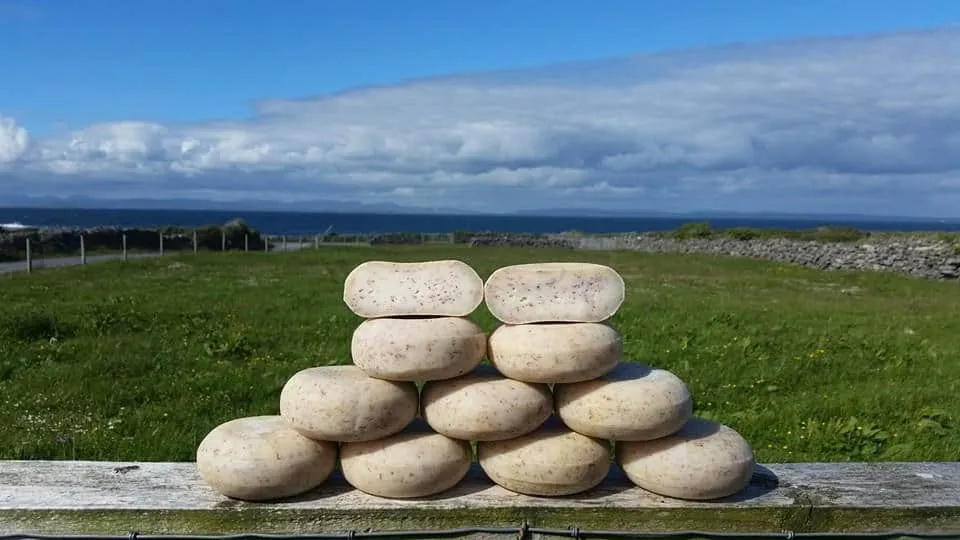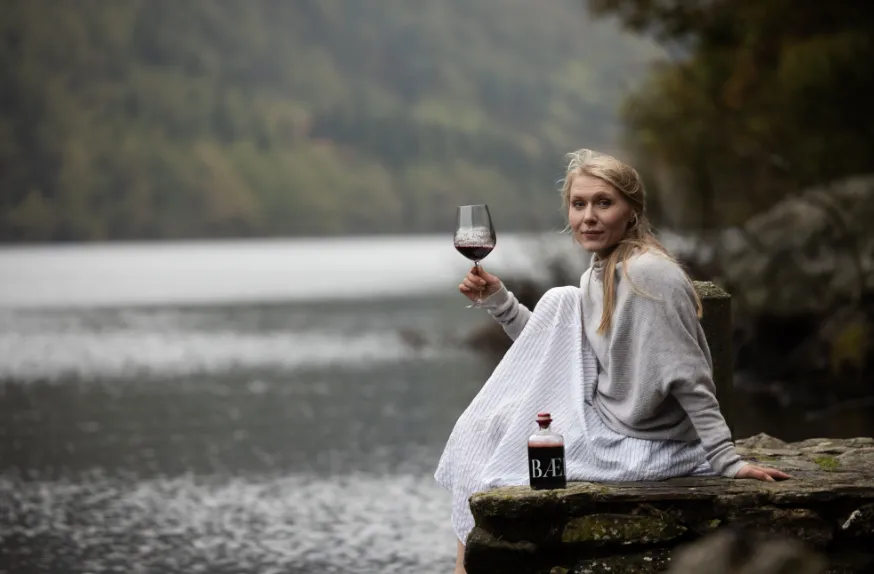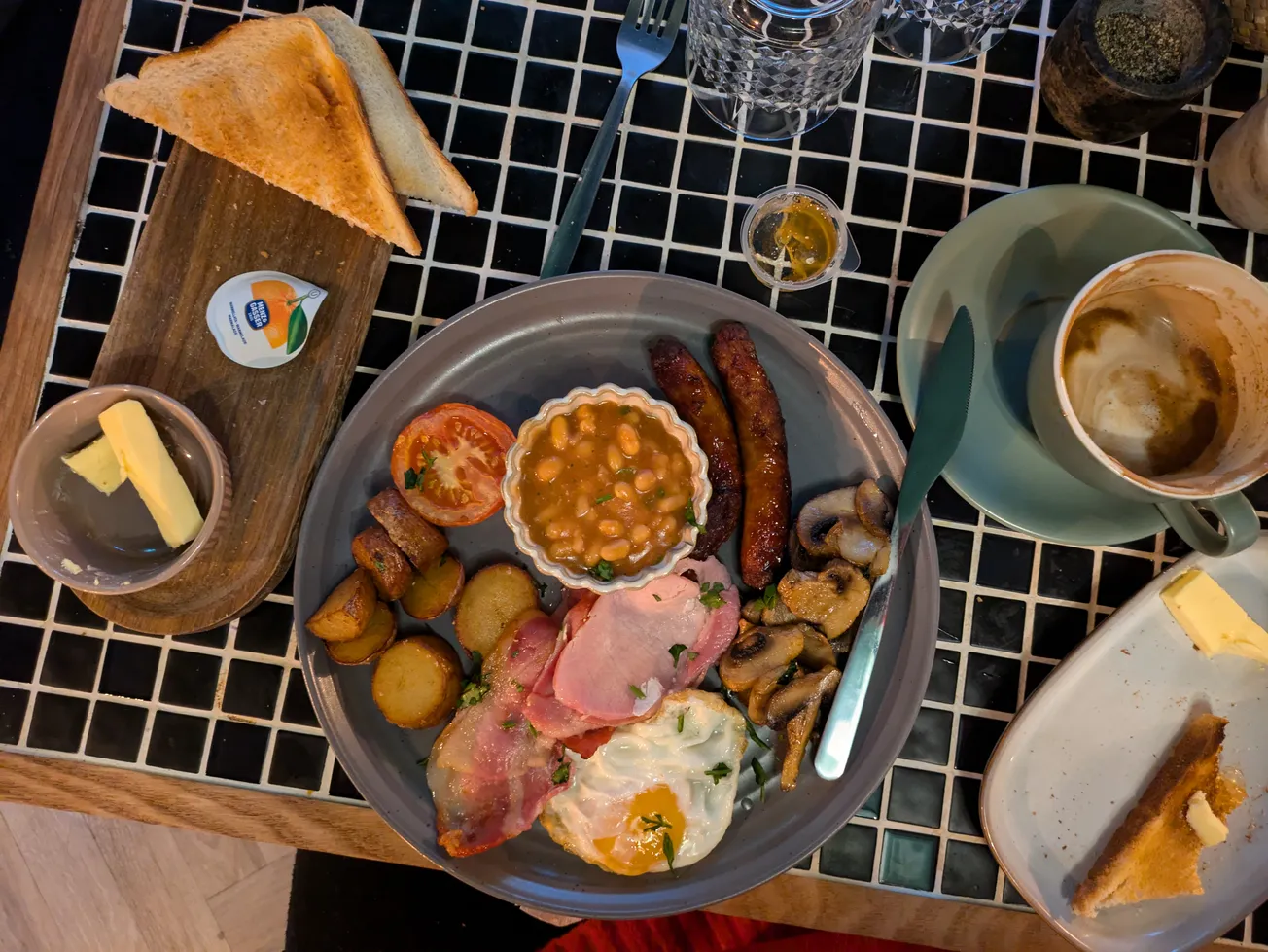Since I visited the Aran Island Goats’ Cheese farm on the island of Inis Mór in Ireland, I can’t stop thinking about my experience—and their rich, dessert-like goat cheese. On this cluster of islands, surrounded by a vast expanse of ocean, the cheese was a destination in itself.
I keep retracing my steps to the ferry. Then, forty minutes later on the island of Inis Mór, pedaling a rented bicycle down the Low Road. To the farm, where I saw twenty or so of Gabriel Faherty’s hundreds of goats munching on a small pasture overlooking the sea.
I keep thinking about the cheese made from their milk and how delicious it was. Sunburned after miles of biking in record high Irish temperatures, past the base of a remote prehistoric fort called Dun Aengus, I walked into Teach Nan Phaidi, the only cafe in sight, to have that locally-made goat cheese among a bed of greens and vegetables—a perfect balsamic salad in the summer heat.
In that summer heat, after long hours outside, by the oceanside landscape, I found that goat cheese tastes better on the edge of Earth.
Whether there is anything to that or if it is just a good Irish fairy tale, I decided to take a closer look at the Aran Island Goats’ Cheese founder, Gabriel Faherty. He started the creamery not only to make use of his family farm, but to also leave a legacy for his four children he shares. Gabriel was encouraged by Brian Lenihan, Jr., then an Irish minister of finance, to leave a twenty-year career as a deep sea fisherman and consider goat farming. They would do well to enjoy the native grasses of the Inis Mór, the statesman said. Within two weeks, a training program for goat farming appeared in the Irish Farmers Journal. Gabriel discussed the idea with his wife Orla, who told him to give it a try. The course lead to further connections with established goat farmers, and Gabriel quickly found himself planning Aran Island Goats’ Cheese. As if looking for evidence to the contrary, Gabriel’s que sera approach to the fate of the farm could be encapsulated by: “Why not goats?”
Indeed, why not. Now, Gabriel and his team make a few goat cheeses: soft cheese with and without dillisk, a local sea lettuce; a summer cheese similar to feta; gouda; and a medium-hard cheese inspired by Parmigiano Reggiano. Which, by the way, Gabriel is very proud of. But he is careful to respect the labeling rights of Parmigiano Reggiano; he likes to joke that his is a parmaran. He initially prepares it as he would his feta, but then puts the cheese on the shelf rather than in a brine, and sprays it with a white mold. He aims for three months of aging, but it is easy to find a five-month cheese on his shelves. In the future, they also want to produce yogurt and ice cream.
It might seem a tad too romantic to drop everything and start a goat farm on the Aran Islands—for anyone but Gabriel. His work is grounded in his years as a deep sea fisherman and tour bus driver on the island. By making use of the family land, his farm becomes a responsible extension of a life already vested in protecting and uplifting his local environment.
With the laborious process of cheesemaking, it makes sense that—even on a remote island of only 900 people—Gabriel Faherty is a hard man to pin down. As the clock ticked and my ferry ride home approached, I began to worry that I’d miss Gabriel during my visit. I’d resigned to snapping photos of the factory and catching him later by phone. But just in time, Gabriel blazed up the dirt road in a station wagon. He’d just finished giving a bus tour of his production facility and farm to visitors. After a polite introduction, I jumped right into my concern about the ferry. He asked me the time and after fumbling for it, he simply told me, “Aye, we’ve plenty of time.” This is quaint, I know, but it’s also how it really is in the west of Ireland.
Aside from quaint, the island is small. Gabriel’s uncle by marriage harvests the dillisk that finds its way into some of the goat cheese, and it is his aunt who owns Teach Nan Phaidi. For the cost of a ferry ride and a bicycle, one can be thrust into the microeconomy of this remote place for an afternoon.
But Gabriel has been involved in the island’s tourism since he was a child and there is something both simple and charming about his variety of agrotourism. If the point is that we pay better attention to the ethics of our food—from source to production—then we can expect neither camp nor mystique. Rather, what we get is a kind of provincial and matter-of-fact look into a place and its people—such that when you breeze through, it can seem almost boring. But upon further reflection, you realize it’s timed like soothing music, each day a perfect song.
Gabriel and I whisked around a back road to the ferry. After we arrived, Gabriel loaded tubs of cheese into the boat. On the mainland, Gabriel’s father would meet the ferry to collect the cheese and then drop it off the next morning to their Galway distributor. They had a cell phone conversation about this during our ride where Gabriel had to turn down the radio and stop singing along to Rag’n’Bone Man: “I’m only human after all/don’t put your blame on me.”
Muted to us, Rag’n’Bone would be singing “some people got the real problems,” about the same time that Gabriel was answering the call and making those plans with his father in Irish. It made me wonder if life on one of the most fabled islands doing something as romantic as batch producing goat cheese can have its busy days. Or maybe the idea of slowing down is overrated. Maybe it’s OK if we’re all hurrying to collect wayward strangers and load our offerings to the world onto the ferry just in time—just as long as we also take a moment to stop and smell the cheese.

Heather Richie is Wade & Wallow's digital editor and has also written for Oxford American, Fly Fisherman, Sporting Classics, and Garden & Gun. A graduate of College of Charleston and Sewanee: The University of the South, her MFA thesis FULL: A Slim Volume on Southern Foodways was accepted for publication by Louisiana State University Press.





